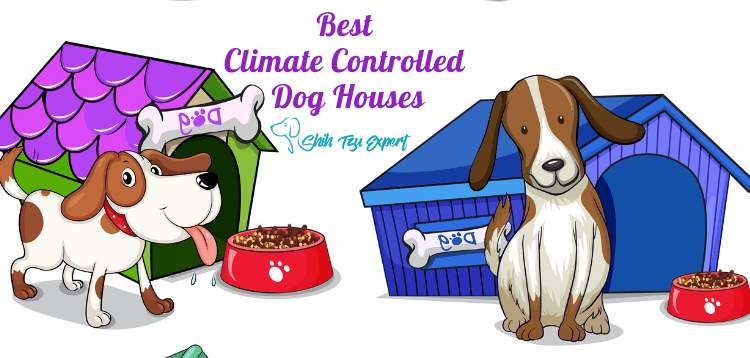
As dog house designs and features become more sophisticated with endless options, climate-controlled dog houses remain a great option to make sure your dog is safe and comfortable.
By thoroughly researching the opinions of dog owners and experts alike, we have compiled a list of the top four best climate controlled dog houses:
-
Boomer & George – Wooden Barn Dog House for Large & Extra Large Dogs with Heater
Pros:
- Extra-large size
- Included heater with safety elements
- Built with durable materials
- Raised floor panel prevents moisture
- Removeable roof makes for easy cleaning
Cons:
- Most expensive on this list
- Only comes in one size
- Customers noted the house cannot fit two medium-sized dogs
- Though the description notes the house is insulated, an answer by the seller to a customer says the house is not insulated

-
ASL Solutions – Deluxe Insulated Dog Palace with Floor Heater
Pros:
- Overall positive reviews from customers
- Plastic material for durability and easy cleaning
- Includes a built-in electric floor heater
- Well-insulated with covered door for comfort and protection from the elements
- Panels can be removed for more airflow
Cons:
- Plastic design isn’t very aesthetically pleasing
- Raised door could make it difficult for smaller or older dogs to enter
- Size may not accommodate larger breeds
- Some customers noted cracks in the plastic, or the panels settling
- No specifications provided on included floor heater
- Floor heater can’t be removed
- Only comes in one size
-
Unbranded – Heated Solid Fir Wood Dog House Kennel Cage
Pros:
- Traditional, neutral design
- Sturdy, durable materials and construction
- Raised floor and weather-proof roof
- Functional extras include two metal bowls and a storage compartment
- Included heater has long life and safety elements
Cons
- Expensive
- Only comes in one size
- Size may not accommodate larger breeds
- Lower-wattage heater
- No customer reviews yet
-
DogEden – Dog House for Small Dogs to Medium Large Dogs
Pros:
- Underground design offers protection and insulation from the elements
- Includes six steps for easy entry and exit
- Least expensive on this list
- Durable plastic material
- Comes in two colors
Cons:
- Underground design requiring digging may not be the easiest installation
- Customers say wild animals including snakes can easily access the house
- Customers say it can’t accommodate a 60-pound dog as stated in description
- Customers say water can get inside
- No visibility if dog is laying inside
- Only comes in one size
- Plain design without any extras
What to look for when buying a climate-controlled / Cooled dog house
Size and shape
What good is a dog house if your dog can’t fit inside? One of the most important factors when buying any dog house is making sure your dog’s weight and height can be accommodated. Make note of the size of the house you’re considering and measure your dog to ensure they can comfortably enter and exit. It’s also critical to make sure they have enough room inside to sit, stand, lie down and turn around. However, if your dog has too much room, they can lose heat faster in cold temperatures. Some experts say the inside of the house should be at least 25% higher than your dog’s height when standing, the door should be 75% of your dog’s height to their shoulders, and that the length of the house from door to back panel should be as long as your dog’s body length. This gives your dog ample room to enter and exit the house, stand or lay down while inside and turn around. Make sure the house you’re buying has a return policy in case measurements are off.
Weight
The weight of a house is more about whether you can move it or not. Lighter houses can be blown by strong winds. Larger dogs can also knock houses over. If you’re considering a lighter-weight house, consider anchoring it to the ground or placing something weighted inside.
Insulation
Especially important when looking at climate-controlled dog houses, insulation options can be vast among dog house designs and brands. Some dog houses come with removeable insulation to accommodate for cooler and warmer temperatures. Houses made of wood tend to have the best natural insulation. The walls of igloo shaped houses, which are usually made from plastic, are usually thicker than other house shapes, also making them well insulated. Houses with closeable or even self closing doors help with insulation and protect your dog from the elements. If the house doesn’t have a door, consider installing your own door or a thick waterproof flap.

Ventilation
A well ventilated dog house is critical for two reasons – to allow increased airflow in warm weather and to make sure your dog has adequate breathable air. A well-made dog house will have the proper balance of both insulation and ventilation. Some houses can be easily customized according to seasons, such as having removeable panels, roofs or window flaps.
You can also add an exhaust fan to increase air circulation. Some dog houses may come with an exhaust fan to increase air circulation, or you can add your own. Solar powered fans are the best eco friendly, non-electrical option.
Waterproofing
Durability
When it comes to your furry friend, you want a dog house that is safe and will last a long time. A house should be able to withstand whatever weather you experience, such as strong winds, snow, rain or sleet. Make sure a house is heavy enough that it doesn’t blow away in strong winds or consider anchoring it to the ground for extra stabilization. A dog house should be sturdy with no gaps between panels or pieces. Wood dog houses can often settle or warp due to weather, but plastic houses often withstand the elements and last longer.
Safety
The entire premise around outdoor dog houses, and especially ones that are climate-controlled, is keeping your dog safe. While most houses are built with safety in mind, including protection from weather, consider other factors like sharp corners, splinters, whether the house is tall and wide enough to accommodate your dog. Considering these elements is especially important if your dog has special needs or is older.
Also watch out for houses painted or treated with toxic paint or chemicals, or plastic houses containing BPA that could harm your dog if they chew it. Online descriptions of dog houses should include what treatment the interior and exterior have and will usually say they are chemical or BPA free if they truly are.
Cleaning
Assembly and mobility
Especially if you’re not the handiest person, make sure you purchase a dog house that’s easy to assemble. Some houses are easier to assemble with two people, so try to find someone to help. Making sure you have the proper equipment or can easily find it is critical. Certain types of houses, such as underground den houses or those requiring ground anchors, require digging holes. Some houses come pre-assembled, so check if that’s the right option for you.
Consider what level of mobility you need in a dog house. Especially if you rent your home or may be moving in the future, making sure you can disassemble and store your dog’s house is important. Even if you’re staying put at your current location, consider if you may be renovating your yard in the future, or simply want to move the house around at some point.
Price
You’ll also want to factor in the price of shipping as well. Depending on the size and weight of the house, shipping can get pricey.

Energy-efficiency
With some climate-controlled dog houses coming with electrical components, it’s important to consider how much power the element will use, whether it’s a heater or air conditioner. Many solar-powered options that won’t increase your power bill can be purchased separately. If you go with an electric option, be sure it includes an auto-shutoff feature (but bring your dog inside before it times out), or make sure to manually turn it off when not in use. This will not only prolong the life of the unit, but it’s better for both your bills and the environment.
Aesthetics
Extra features
In addition to proving housing and protection for your dog, dog houses can come with a plethora of extra features. Some include storage, food and water dishes with mounts, covered porches, rooftop platforms, built-in beds and more. The sky’s the limit when it comes to extra features include din dog houses, or those you can purchase separately for a truly custom and functional experience for your pooch.
Adding extra protection and comfort
Just about any dog house is able to be customized to add extra protection and fit your pet’s needs. No matter what kind of house you buy, consider adding one or more of these extras for more protection and comfort:
Blankets or straw
Adding an extra layer on the floor of the dog house both makes your pet comfortable and helps them stay warm. Blankets are an option if your dog house is extremely insulated or under a porch with no chance of water getting inside. However, if blankets get wet in cold temperatures, they can freeze, opening up your dog to illness from laying on a wet surface. Straw (not hay) is the best option for outdoor dog houses, as it repels moisture and keeps in heat.
Heaters or air conditioners
Yes, you can buy your dog his or her own air conditioner. Much like their heater counterparts, these air conditioners are specifically built for dog houses. This is definitely something to consider if you live in an extremely hot environment and your dog spends a lot of time outside. Solar-powered options help save electricity and money.
Heated food and water dishes
If your dog spends a lot of time outside, heated dishes are a must. Especially if you live in a colder climate, these types of bowls keep water and wet food from freezing. With hydration being so important to your dog’s health, making sure they have easy access to water is vital.
Thermometer
A thermometer may be one of the easiest yet most important additions to any dog house. They’re cheap and easy to read so you can ensure your dog’s house isn’t too hot or too cold. If your dog has to stay out for a period of time, always check the house’s thermometer and make proper adjustments.
Additional insulation and waterproofing
Most climate-controlled dog houses will come substantially insulated and waterproofed. However, if you’re looking for even more protection, or if your dog house isn’t properly insulated, consider adding your own. Installing extra insulation (but making sure it’s covered), waterproof liners, house doors or waterproof flaps help insulate the house and keep your dog safe and warm. Putting the house under a covered area, such as a deck, porch or shed also helps insulate and protect both the house and your dog.




